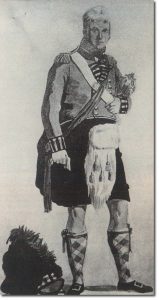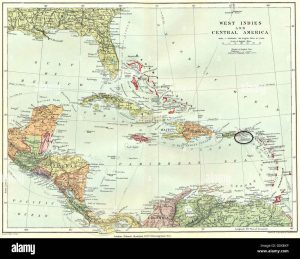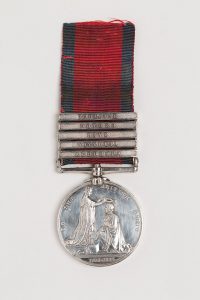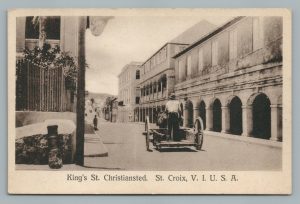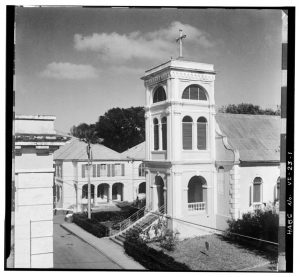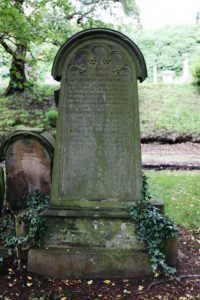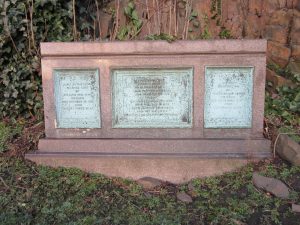Written by Ian H Grant (1994). Revised by R N Hector Grant (2016).
RICHARD ROBB GRANT was born 16th February 1823 at the house in Calton Place where the family home was then situated. The location has had a number of changes over the years but it was then situated on rising ground overlooking Glasgow Green and a short distance to the east of St. Andrews Square. The Burgh of Calton had of old consisted of a short string of houses on either side of the rough road which became an extension of the Gallowgate, there was also a barracks situated there which was mainly utilised for accommodating troops which had to be brought in on the odd occasions when disturbances erupted in the town and the burgesses required protection of their properties. About 1807 the fast expanding Burgh of Glasgow secured an Act of Parliament to incorporate Calton into the city, and many other neighbouring burghs were to experience the same fate over the course of the following two centuries.
Richard was to enjoy a happy childhood there and attended school up to the then leaving age of twelve and had sufficient grounding to pass the university matriculation examinations in 1835.He continued his studies there for some years attending classes in subjects appropriate to employment in the mercantile and commercial spheres. Two certificates, which have been handed down, attest to his attendance at courses in “Private Logic & Rhetoric” and in “Political Economy” at the University; the last of these being dated in November 1851 indicates that he continued to further his education for at least fifteen years. It is probable that he worked in his father’s firm until Hector died in 1840, but, as a consequence of the absence of a Will and the necessity to identify and realise heritable property the firm had to be made over to administrators; Richard was neither a beneficiary nor likely, as a seventeen year old, to be able to manage the business. He and his mother together with any other members of the family who had not become independent by that time were to move their home to 5 Maxwelton Place.
For a few years he was employed with Bodstein & Company, Calico Printers then located at 78 Miller Street. In 1847 Richard entered a business partnership as Paton & Grant, Ship and Insurance Brokers operating from 33 Buchanan Street. Undoubtedly the previous two decades had seen an astonishing change in Glasgow’s industrial and commercial importance and the enterprise of her marine engineers had made this unlikely location the world leader in the production of steam powered iron hulled ships which had the capability of navigating the oceans of the world with a speed and certainty that was far superior to the age-old reliance on sail. In economic terms there were still many improvements to come and though the heyday of the “clipper” sailing ship, which benefited from the hull designs developed for steamships, was still to come their seasonal dependence on trade winds spelled their demise before the century ended. However the marine engineers were quick to develop entrepreneurial skills, initially by creating a market in the form of shipping companies, known as steam packet lines, serving ports across the Irish Sea, the English Channel, on the east coast from Shetland to the Thames and Scotland’s Western Isles. Thus Glasgow also became a trailblazer in the formation of ocean-going steamship companies with the financial and operating skills, which were necessary for their profitable performance. The long established centre for marine insurance underwriting was Lloyd’s of London and it was to remain so, however they traditionally rely on brokers to introduce the business and present a knowledgeable exposition of the technicalities so that the underwriter can make a fair assessment of risk. The firm of Paton & Grant did become a very successful Shipbroker and no doubt Richard’s connections with the Napier family were to assist and prove mutually beneficial.
At the time of their marriage in August 1857,Richard Robb Grant was 34 years of age and Catherine Napier was 27 years and their first home was at Rose Street, Garnethill – this being within short walking distance of the Napier’s Bath Street house on the other side of Sauchiehall Street. In those days when public transport was hardly envisaged this close proximity to family and friends was very desirable and during the eight remaining years of Rev. Peter Napier’s life he was to enjoy the regular visits from his daughters and grandchildren. Later in the year in which he was married, Richard was to make a further business venture by purchasing a partnership in an old established engineering firm trading as the Canal Basin Foundry. This firm had been established in 1792 by Messrs. H. & R. Baird who, as civil engineers had been involved in the construction of the Forth & Clyde and Monklands Canals, and on its completion set up a foundry at Port Dundas which was the basin for canal traffic and the distribution point for Glasgow. As a result of deaths and retirements the owning partnerships had changed over the years and was now to become Turnbull, Grant and Jack. Richard Grant continued to devote most of his time to the insurance agency and, not being a practical engineer, left the day-to-day operations to his partners whilst maintaining an administrative oversight. The firm continued for some thirty years until a radical change in circumstances gave rise to a serious misfortune for the Grant family, which will be explained later.
Within a short time of her father’s death Catherine, Richard and their five children moved to a new home at 8 Windsor Terrace in the vicinity of St. George’s Cross and in the parish of St. George’s-in-the-Fields where Rev. Peter Napier had ministered in his first charge. It was at this house that three younger sons, Richard, James Home and Peter Napier Grant were born and, as our narrative will mainly concentrate on this younger Richard, it might be helpful to enumerate the brief details of the eight children in the family.
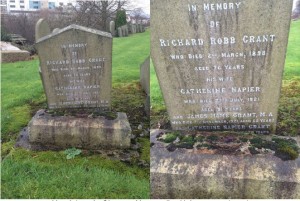
Grant Family Headstone
Richard Robb Grant (1823-1898) & Catherine Napier (1830-1921) Marriage Certificate 11/8/1857 – District of Blysthwood.
Children
1) Catherine (1860-1938) – Did not marry – cared for her mother.
2) Agnes Robb (1861-1938) – Married 1887 to widower Ninian Glen C.A.& Actuary (1857-1912) a son of Rev. John Glen, step-son of Rev. Dr. Peter Napier. They had a son, also Ninian, who died in infancy.
3) Hector (1863-1948) – A marine and civil engineer. Remained a bachelor.
4) Edith (1864-1934) – Married James Pattison, Writer in Glasgow. No children.
5) Jane (1864-1946) – Married Dr. Alexander Davidson MD who was drowned in Gold Coast whilst on colonial service circa 1910. Their two children were: –
Jean (1893-1970), married Harold Hill, had daughter Pamela, 1922 still alive.
Archibald (1895-1975): bachelor.
6) Richard (1867-1952) (known as DICK) – Married Belissa E.K.Beresford, widow of Commdr. Philip Kell RNR.
7) James Home (1868-1924) – M.A.teacher and bachelor.
8) Peter Napier (1870-1942) – M.D.in Glasgow and married to Margaret Agnes Hughes (1880-1970). Had one son-Peter Napier Hughes Grant M.R.C.V.S. (1920 – who married Joan Taaffe (d.1992).
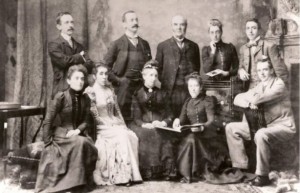
GRANT FAMILY CIRCA 1890
Back Row from Left to Right Richard (Dick), Hector, Richard Robb, Agnes, Peter
Front Row from Left to Right Edith, Kate, Catherine (Napier), Jeannie, James
By the time Richard and Catherine were married and their children were young there was considerably more emphasis on family socialising and domestic interchanges with Napiers, many of whom lived and worked in and around the city; whereas a number of Richard’s brothers and sisters had died and the others had moved to counties in southern Scotland. Only he remained in the city and though there were cousins they tended to become more remote. There had always been an affectionate relationship between Catherine and her uncles Robert and James and their wives, moreover their children and her own sisters and step-sisters remained close. Uncle Robert had built his large mansion house at Shandon, overlooking the Firth of Clyde, in the early eighteen fifties, partly to accommodate his magnificent Art Collection but more specifically to act as a generous host to their family, friends and business associates. Until the death of his wife, Isabella, in 1873 the Grants were often to take trips “doon the water” by paddle steamer, landing at Helensburgh pier where they were met by Uncle Robert’s coachman and transported via Rhu, to the fairy castle of West Shandon. More mundane but equally entertaining were visits to Uncle James at his house on Partick Hill, a district which he knew intimately having started his engineering business there in 1820 when it was a small collection of croft houses. By the time of his death in 1873 it had expanded into a huge industrial and housing conurbation of the city of Glasgow and his interest extended to publishing a small book on the history of old Partick. By 1870 Richard and Catherine had moved with their family to a fine new block of red sandstone houses, their address being No.3 Hillside Gardens, at Partickhill. There Richard was to become a founding member and considerable benefactor in the building of the new Hyndland Parish Church in which the children, by dint of regular attendance, were well grounded in Christian ethics and the Presbyterian faith which their parents held dear and were duty bound to instil in their off-spring.
Our previous review of ancestral experiences of members of the Clan Grant and its cadet lines indicated the inequitable and often disastrous consequences which affairs of Crown, State and Religion imposed on the ordinary people in their different localities as the different establishments sought to weld diverse communities into a homogenous whole nation of Scotland. To some extent the simple clan loyalties of the Highlanders are more easily understood than the motivations of the Lowlanders in the central and southern areas of Scotland. Many of the Border counties and their communities had for centuries suffered economically and physically, and particularly from the incursions instigated by Edward 1 of England in his abortive attempts to extend his domains. In the period between the Union of the Crowns and the Parliaments of the two countries the southern Scots had, by virtue of their proximity to England, suffered much more than their fellow countrymen of the north, from the duplicity of the Stuart monarchs, who had embraced the Episcopalian religion of England and endeavoured to inflict it on the Scottish people. The Confession of Faith and the Reformation of a hundred years earlier, confirmed by James IV of Scotland, was hard won, of recent memory and dear to the hearts of all Scots. When Charles I had the temerity to insist that the Liturgy and English Book of Common Prayer was to be used in all Churches of Scotland, Presbyterians refused to comply. In 1638 a great meeting was held in Greyfriars churchyard in Edinburgh and the famous National Covenant was drawn up and attested there and throughout Scotland. Subsequently the “Covenanting Party” held a free General Assembly in Glasgow and their intentions were precisely stated to the Crown. The Covenanting Times were to extend over a period of sixty years, though there was an interlude of a dozen years of comparative tolerance during the time of Oliver Cromwell’s Commonwealth.
The Puritans in England had suffered persecution for an even longer time and that had culminated in the execution of Charles I, however the Royalists again became dominant after Cromwell’s death and, with the restoration of Charles II in 1660, the troubles of the Covenanters multiplied. The persecution and injustice continued with many suffering exile, imprisonment and cruel death until the so-called “Glorious Revolution” and the enthronement of William and Mary of the protestant House of Orange in 1688. Unlike the Highlands of Scotland, where as we have seen the inherited loyalty to the Stuart dynasty continued until Culloden, south and central Scotland had embraced the Presbyterian ethos which eschewed the divine right of Kings in favour of the hopefully democratic politics of State and Parliament. The Union of the English and Scottish parliaments was directed towards this improvement in the ‘rights of mankind’ and the introduction of the Hanoverian dynasty was to consign the monarchy to a constitutional role.
By virtue of his position as a partner in the engineering business of the Canal Basin Foundry Richard Robb Grant was admitted to the Incorporation of Hammermen of Glasgow in August 1875 and became a Burgess and Guild Brother of the Burgh at the near-hand, being a younger son of Hector Grant, Merchant and a former Burgess of Glasgow. By this Ticket he was ” bound to perform all the civil duties and obligations by law incumbent on a Freeman Citizen of Glasgow”. The civil duties and obligations imposed on a Burgess had in the sixty years since his father’s admission to that status, altered radically in so far as commitment to Church, Crown and Burgh were concerned. Incumbencies “by law” were henceforth to play an increasingly dominant role as Parliamentary legislation became enforceable and acceptable in the interests of the greater good of all men.
In the latter years of the eighteenth century when Hector and his brothers arrived in Glasgow burghal government was very much under the control of the Provost and Baillies whose appointment was made by the Merchant House and the Incorporations of Trades Houses, effectively the people who had an interest in the commerce and property of the town and the system was endorsed by the Crown by an appropriate burghal status. No one could operate as a tradesman or merchant without admission to the appropriate Incorporation and in order to conduct a business the applicant had first to produce evidence of membership of either the Merchant House or one of the Trades Incorporations. Hector’s brothers had pursued their skills as Weavers and entered through that ancient incorporation, but he had trained in accountancy and administration for which there was no recognised profession or trade and he obtained admission to the Company of Grocers and the Merchant House by which he was admitted as a Burgess and Guild Brother. Clearly the consequences of the Industrial Revolution fostered an increasing diversity of occupations and by the end of the nineteenth century the Merchants and ancient trade incorporations had lost most of their of their impact. A proliferation of professional societies and trade unions which were representative of much larger numbers of persons arose to take their place and, though they continue as organisations dedicated charitable causes and acknowledgement of the city’s business and cultural heritage, for the bulk of the citizens their existence is neither appreciated nor understood.
As an indication of the social change which had occurred in Glasgow in the sixty years between father’s and son’s admission to the Burgess Roll it is interesting to observe the obligations which were undertaken by the earlier Freeman in 1815, and relate these to ordinary life at that time. There had not been much popular conception in Scotland of events in Europe such as the French Revolution; though involvement in the Napoleonic Wars was more pertinent it took some ten days of laborious post haste by land and sea for news to reach Glasgow of the outcome of the Battle of Waterloo. Population counts were notoriously unreliable but it would not be unreasonable to suggest that there was a tenfold increase in the number of citizens during these sixty years and that created enormous logistical problems in every phase of living. Perforce many of the long held establishment tenants had to be revised as is evident from the stipulation of the earlier Burgess oath, which contained these undertakings:
“Here I protest before God that I confess and allow with my heart the true RELIGION presently professed within this Realm and authorised by the Laws thereof. I shall abide thereat and defend the same to my Lifes end, renouncing the Roman Religion called Papistry. I shall be leal and true to our Sovereign Lord, the KING’S MAJESTY and to the Provost and Baillies of this Burgh. I shall obey the Officers thereof, fortify, maintain and defend them in the execution of their Office with my body and goods. I shall not colour a freeman’s goods under colour of my own. In all taxations, watchings and wardings, to be laid upon the Burgh, I shall willingly bear my part thereof as I am commanded thereto by the Magistrates; I shall not purchase or use exemptions to be free thereof renouncing the benefit thereof forever. I shall do nothing hurtful to the Liberties and common well of this Burgh. I shall not brew, nor cause brew, any malt but such as is grounded at the Town’s milns and shalt grind no other corns, except wheat, pease, rye and beans, but at the same allenarly. And how often I shall happen to break any part of this oath, I oblige me to pay, to the common affairs of this burgh the sum of One hundred pounds Scots money and shalt remain in ward while the same be paid. So help me God. I shall give the best council I can, and conceal the council shown to me. I shall not consent to dispone the common goods of this burgh, but for ane common cause, and ane common profit. I shall make concord, where discord is, to the utmost of my power. In all tienations and neighbourhoods I shall give my leal and true judgement, but price, prayer or reward. So help me God”.
Hector Grant, Merchant having paid his fine was admitted at the far hand (not being the son of a Burgess), having given his oath, as above becoming a Burgess and Guild Brother.
These were the parameters under which the businessmen conducted trade, usually as individuals or partnerships, in the now United Kingdom of Great Britain and Ireland for most of the nineteenth century. Napoleon referred to us disparagingly as a “nation of shopkeepers” but was to find to his cost that the mercantile integrity of the nation was solidly founded on moral principles, which for centuries had adhered to the objective of common wealth. There always has been and always will be the human factor of self interest but, whilst we may be critical of oaths of allegiance written on tablets of stone, there is no doubt that ethics are the integral cornerstone of society. The fathers of the Scottish Reformation were vociferous in their support of universal education at a time when most states in Europe feared that the spread of learning would undermine their dynastic authority, as indeed it was to prove. For each of us our short lifespan is our period of learning and we have to work hard to interpolate that into even a smattering of wisdom.
Richard as we have seen was to follow his father as a Burgess of Glasgow in 1875 and by then the office was more or less nominal as regards influence, however the obligations were to remain significant in his conduct of business. On the personal side he had already given an undertaking to his wife’s uncle Robert Napier, to act as one of the Trustees of his estate on his death. Sadly this was to happen in the same year of 1875 and as a result of the wide spread of Robert’s financial interests and a somewhat cavalier regard to their disposition as a consequence of earlier differences between himself and his heir apparent, the seven Trustees whom he had appointed were to become involved in difficult and extended decisions as regards managing the assets over a period of many years. The main beneficiaries were two sons and three daughters, none of whom were Trustees, nor was any willing to assume the responsibilities of continuing the operations of the firm – Robert Napier & Son – which their father had built up over a span of sixty years and, for much of that time, was the most reputable steamship builder in the world.
Whilst it is not practical at this point to comment on the circumstances, which lead to the demise of the shipbuilding firm without reverting to its full history, some appreciation of the problems facing the trustees may be gleaned from a few observations. The eldest son and heir James R., who was being groomed as successor, had twenty-five years earlier demurred from taking over when his father had indicated a wish to retire in his early sixties. He resigned from the firm and old Robert continued with the younger son John R. and his long-time colleagues, his brother James as general manager and David Elder his chief of engineering. The two latter predeceased him and John R. never aspired to executive responsibility and terminated his employment with the firm on his father’s death. The daughters were all well married and without interest in the business and by mutual agreement of the children the mansion at West Shandon was to go, together with the fabulous Art Collection, sold by auction at Christies, listed in an extensive book and involving some sixteen days under the hammer. James R. died within three years of his father and leaving numerous subsequent heirs.
The settlement of the firm was far more intractable. Some of the Trustees with personal involvement in the marine engineering sphere insisted on its continuation under professional management. This was by no means successful and sixteen years later it was floated as a public limited company, which in turn was bought out by Beardmores – which coincidently had evolved into a huge industrial conglomerate from the forges in Camlachie and Parkhead set up by Robert Napier and his son-in-law William Rigby seventy years earlier.
As a Trustee Richard R. Grant dutifully carried out his obligations and commitments but it was a heavy burden of responsibility, which detracted somewhat from the attention which he was able to give to his own business venture into the field of engineering. The senior partner in Turnbull, Grant & Jack took retirement in 1886 necessitating the purchase of his major interest by the remaining two partners. Unfortunately Mr Jack died two years later and Richard was to find himself in the virtually impossible position of putting up two thirds of the capitalization – £20,000 a very large sum in those days when, for example, a fully equipped 70 ton steel hulled steamship was built and delivered for a quarter of that sum. He did in fact make a generous settlement in favour of the Turnbull and Jack families, forming a private limited company in which John Turnbull Jnr. retained a small interest left by his father. It was then proposed to float the Canal Basin Foundry as a Public Limited Company by the offer for sale of 6% Debentures as unfortunately in the detailed assessment of the firm’s property, machinery and stocks it was revealed that a substantial additional sum would require to be expended on modernisation. By the eighteen-nineties it was becoming clear that there was considerable excess capacity in the engineering industry and the periodic slumps ensured that only the most efficient firms could expect financial support. The floatation of the Company was not successful and the enforced sale of the firm’s assets did little to mitigate Richard’s indebtedness. Although his Insurance Broker business continued to provide an income it became necessary to realise all available personal assets, and the family was sorely afflicted. No doubt Richard had regrets as regards his earlier munificence and his failure to ensure that the original partnership was registered under the legislation for limited liability – this was however a comparatively recent innovation in 1857 and very few of the old established firms had by then appreciated it efficacy.
The realisation of his own financial vulnerability in the partnership situation manifested itself in 1886 with the retirement of John Turnbull Snr and the death two years later of William Jack, by which time Richard himself was sixty-five, and no provision had been made for the continuity of the business. As a wellknown and reputable businessman in Glasgow he had no difficulty in securing loans against his own and the firm’s assets but over the course of the next four years it became clear that a costly reorganisation was inevitable. There was a consequential run-down in confidence and profitability and the failure of the floatation meant that a Liquidator had to be appointed.
The family home had to be sold to satisfy Richard’s debts and all his personal assets realised or committed. Fortunately Catherine had some personal means and there were mitigating contributions from others in the family. The two older girls, Kate still lived at home with their parents but Agnes had married in 1887 and the younger twin girls, Edith and Jane were married by 1893. Younger sons James and Peter were still students at university and not earning, however Hector and Dick were in the happier position of having completed their engineering apprenticeships and both willingly made over most of their salaries to assist in the household upkeep. The family moved to Hope Villa in Lenzie, a more modest rented house in what was then virtually a country town but having the advantage of a railway service to Glasgow. Richard was never to forgive himself having brought these problems on his nearest and dearest and his efforts to resolve the family fortunes were frustrated by the progressive onset of senility. In the last year or so before his death in 1898 he was committed to a sanatorium, which was a sad end to a selfless and devoted father who had devoted his productive years to the benefit of his large and appreciative family.
Prior to their father’s death both Hector and Dick had taken up engineering contracts abroad which ensured a higher level of earnings, which they were able to remit to their mother. James qualified as a Master of Arts and entered the teaching profession and Peter as a Doctor of Medicine had appointments in hospitals and lived with their mother and sisters who were soon to move back to a flat in Glasgow. Agnes and Peter were to marry some years later, and mother Catherine lived until 1921 and the good age of ninety-one.
